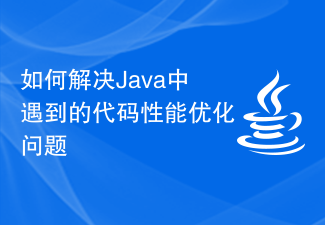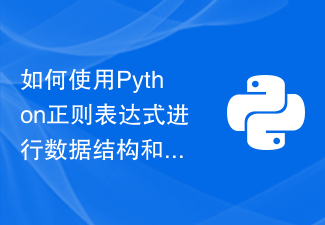 Java
Java javaTutorial
javaTutorial A closer look at Java Map: Uncovering the secrets of efficient data storage and retrieval
A closer look at Java Map: Uncovering the secrets of efficient data storage and retrieval
php editor Zimo will take you to deeply analyze Java Map and explore the secret of efficient data storage and retrieval. Map is one of the commonly used data structures in Java, which is very convenient for storing key-value data. By understanding the internal implementation principles and usage techniques of Map, we can help developers better use Map to improve program performance and efficiency. Let us uncover the mystery of Java Map together and master the essence of data storage and retrieval!
import java.util.HashMap;
import java.util.Map;
public class JavaMapDemo {
public static void main(String[] args) {
// 创建一个HashMap实例
Map<String, Integer> studentMap = new HashMap<>();
// 添加键值对
studentMap.put("John", 90);
studentMap.put("Mary", 85);
studentMap.put("Bob", 95);
// 获取键对应的值
Integer johnScore = studentMap.get("John");
System.out.println("John"s score: " + johnScore);
// 检查是否包含某个键
boolean containsMary = studentMap.containsKey("Mary");
System.out.println("Contains Mary: " + containsMary);
// 删除键值对
studentMap.remove("Bob");
// 遍历所有键值对
for (Map.Entry<String, Integer> entry : studentMap.entrySet()) {
System.out.println(entry.geTKEy() + " : " + entry.getValue());
}
}
}
In the above code example, we demonstrated how to use HashMap to store and retrieve data. First, a HashMap instance studentMap is created. Then, we use the put method to add three key-value pairs to the Map: John corresponds to 90 points, Mary corresponds to 85 points, and Bob corresponds to 95 points. Next, use the get method to obtain John's score, and use the containsKey method to check whether the Map contains the key Mary. Next, Bob's score is removed using the remove method. Finally, use the entrySet method to traverse all key-value pairs in the Map.
Java Map’s hash function is the key to efficient working of hash tables. The hash function converts the key into a hash value, which determines where the key-value pair is stored in the hash table. A good hash function can evenly distribute keys across buckets in the hash table, thereby reducing collisions and improving retrieval efficiency.
Java Map also provides a rich api to support various operations, such as adding, deleting, updating and retrieving key-value pairs. In addition, Map can also be used with other data structures, such as linked lists, trees, etc., to achieve more complex storage and retrieval needs.
By deeply analyzing the working principle of Java Map, we can better understand the secret of its efficient data storage and retrieval. Map is widely used in various fields, such as caching, database, website indexing, etc., all of which are inseparable from its excellent performance and convenient operation. Learning and mastering the knowledge of Java Map is of great significance for improving programming efficiency and solving various data storage problems.
The above is the detailed content of A closer look at Java Map: Uncovering the secrets of efficient data storage and retrieval. For more information, please follow other related articles on the PHP Chinese website!
 Java中的二叉树结构详解Jun 16, 2023 am 08:58 AM
Java中的二叉树结构详解Jun 16, 2023 am 08:58 AM二叉树是计算机科学中常见的数据结构,也是Java编程中常用的一种数据结构。本文将详细介绍Java中的二叉树结构。一、什么是二叉树?在计算机科学中,二叉树是一种树形结构,每个节点最多有两个子节点。其中,左侧子节点比父节点小,右侧子节点则比父节点大。在Java编程中,常用二叉树表示排序,搜索以及提高对数据的查询效率。二、Java中的二叉树实现在Java中,二叉树
 Python 实现栈的几种方式及其优劣May 19, 2023 am 09:37 AM
Python 实现栈的几种方式及其优劣May 19, 2023 am 09:37 AM想了解更多关于开源的内容,请访问:51CTO开源基础软件社区https://ost.51cto.com一、栈的概念栈由一系列对象对象组织的一个集合,这些对象的增加和删除操作都遵循一个“后进先出”(LastInFirstOut,LIFO)的原则。在任何时刻只能向栈中插入一个对象,但只能取得或者删除只能在栈顶进行。比如由书构成的栈,唯一露出封面的书就是顶部的那本,为了拿到其他的书,只能移除压在上面的书,如图:栈的实际应用实际上很多应用程序都会用到栈,比如:网络浏览器将最近浏览
 PHP8中会支持的数据结构,将为你的代码提供更大空间Jun 21, 2023 am 08:13 AM
PHP8中会支持的数据结构,将为你的代码提供更大空间Jun 21, 2023 am 08:13 AMPHP是一种广泛使用的脚本语言,被广泛用于Web开发,服务器端编程以及命令行编程等。随着PHP不断更新和发展,它也日益成为一个更强大的编程工具,为用户提供了更多的功能和更多的工具来开发高质量的应用程序。其中,数据结构是一个非常重要的领域,一种有效的数据结构可以大大提高程序的性能和可读性。在这篇文章中,我们将讨论PHP8中支持的新数据结构,这些新的数据结构将让
 如何解决Java中遇到的代码性能优化问题Jun 29, 2023 am 10:13 AM
如何解决Java中遇到的代码性能优化问题Jun 29, 2023 am 10:13 AM如何解决Java中遇到的代码性能优化问题随着现代软件应用的复杂性和数据量的增加,对于代码性能的需求也变得越来越高。在Java开发中,我们经常会遇到一些性能瓶颈,如何解决这些问题成为了开发者们关注的焦点。本文将介绍一些常见的Java代码性能优化问题,并提供一些解决方案。一、避免过多的对象创建和销毁在Java中,对象的创建和销毁是需要耗费资源的。因此,当一个方法
 Java语言中的数据结构与算法介绍Jun 10, 2023 pm 01:37 PM
Java语言中的数据结构与算法介绍Jun 10, 2023 pm 01:37 PM随着计算机科学的不断发展,数据结构与算法成为了计算机科学领域中最为基础、重要的模块。数据结构是一种组织和存储数据的方式,它是解决问题的基础。算法则是计算机科学的核心,它是指在计算机程序中解决问题的方法和技术。Java作为一种广泛应用的编程语言,其自带的数据结构和算法库是非常强大的,赋予了开发人员更多的力量。一、数据结构Java中提供了多种数据结构,包括数组
 go语言有哪些数据结构Dec 16, 2022 pm 02:00 PM
go语言有哪些数据结构Dec 16, 2022 pm 02:00 PMgo语言数据结构有四大类:1、基础类型,包括整型(有符号和无符号整数)、浮点数、复数、字符串(由不可变的字节序列构成)、布尔值(只有true和false两个值);2、聚合类型,包括数组、结构体(是由任意个任意类型的变量组合在一起的数据类型);3、引用类型,包括指针、slice(是一个拥有相同元素的可变长度序列)、map、function、channel;4、接口类型。
 c语言中数据结构是什么?常见数据结构有哪些?Nov 03, 2020 am 11:38 AM
c语言中数据结构是什么?常见数据结构有哪些?Nov 03, 2020 am 11:38 AMc语言中,数据结构是指相互之间存在一种或多种特定关系的数据元素的集合,它是计算机存储、组织数据的方式;常见数据结构有:线性数据结构(数组、链表、栈、队列和线性表)、树形结构(二叉树、完全二叉树、二叉查找树、堆)、图形结构(有向图和无向图)。
 如何使用Python正则表达式进行数据结构和算法Jun 22, 2023 pm 08:01 PM
如何使用Python正则表达式进行数据结构和算法Jun 22, 2023 pm 08:01 PMPython正则表达式是一种基于模式匹配的字符串处理工具,它可以帮助我们快速有效地从文本中提取所需信息。在数据结构和算法中,正则表达式可以用来实现文本匹配、替换、分割等功能,为我们的编程提供更加强大的支持。本文将介绍如何使用Python正则表达式进行数据结构和算法。一、正则表达式的基础知识在开始之前,先了解一下正则表达式的一些基础知识:字符集:用方括号表示,


Hot AI Tools

Undresser.AI Undress
AI-powered app for creating realistic nude photos

AI Clothes Remover
Online AI tool for removing clothes from photos.

Undress AI Tool
Undress images for free

Clothoff.io
AI clothes remover

AI Hentai Generator
Generate AI Hentai for free.

Hot Article

Hot Tools

SublimeText3 Chinese version
Chinese version, very easy to use

SublimeText3 Mac version
God-level code editing software (SublimeText3)

MantisBT
Mantis is an easy-to-deploy web-based defect tracking tool designed to aid in product defect tracking. It requires PHP, MySQL and a web server. Check out our demo and hosting services.

Dreamweaver CS6
Visual web development tools

DVWA
Damn Vulnerable Web App (DVWA) is a PHP/MySQL web application that is very vulnerable. Its main goals are to be an aid for security professionals to test their skills and tools in a legal environment, to help web developers better understand the process of securing web applications, and to help teachers/students teach/learn in a classroom environment Web application security. The goal of DVWA is to practice some of the most common web vulnerabilities through a simple and straightforward interface, with varying degrees of difficulty. Please note that this software





